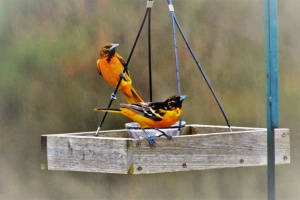- Icterus galbula
Identification
(7-8.5") L. 18-22cm
Male
- Black head, back, wings, and tail
- Orange breast, rump, and shoulder patch
There is no other eastern bird which resembles the male Baltimore Oriole.
Female
- Olive-brown above
- Dull yellow-orange underparts
- 2 dull white wing bars
Distribution
Breeds from Saskatchewan and Nova Scotia south through the Dakotas south to eastern Texas, Louisiana, and Virginia. Winters in Florida, along southern Atlantic coast of the United States, Central America, and northern South America. Rare vagrant to California.
Casual vagrant elsewhere in the western United States.
Accidental vagrant to Greenland, Iceland, Ireland, the UK, Norway, the Netherlands, and Chile.
Taxonomy
The Baltimore Oriole was once combined with the western counterpart Bullock's Oriole as a single species, the Northern Oriole, because they began to interbreed on the Great Plains, when the two forms extended their ranges and met.
This is in spite of these two forms not being each others closest relatives (the closest relative of Baltimore Oriole is the Black-backed Oriole.
This is a monotypic species[1].
Habitat
Deciduous woodlands and shade trees. Before the tree's decline, the American elm was a favorite nesting site for the eastern bird.
Behaviour
Very acrobatic in the tree canopy.
Diet
Their diet consists mainly of insects and fruit.
Breeding
Four to six greyish eggs, spotted and scrawled with dark brown and black. Nest is a well-woven pendant bag of plant fibres, bark, and string, suspended from the tip of a branch.
Vocalisation
Song: Clear and flute-like whistled single or double notes in short, distinct phrases with much individual variation.
Call: A harsh check call given during alarm by both male and female.
In Culture
The Baltimore Oriole is the State Bird of Maryland
References
- Clements, J. F., T. S. Schulenberg, M. J. Iliff, D. Roberson, T. A. Fredericks, B. L. Sullivan, and C. L. Wood. 2018. The eBird/Clements checklist of birds of the world: v2018. Downloaded from http://www.birds.cornell.edu/clementschecklist/download/
- Birds of America
- Birdforum thread discussing the Taxonomy of New World Orioles
- Birdforum thread discussing the hybridization in "Northern Orioles"
Recommended Citation
- BirdForum Opus contributors. (2025) Baltimore Oriole. In: BirdForum, the forum for wild birds and birding. Retrieved 11 May 2025 from https://www.birdforum.net/opus/Baltimore_Oriole
External Links
GSearch checked for 2020 platform.1








